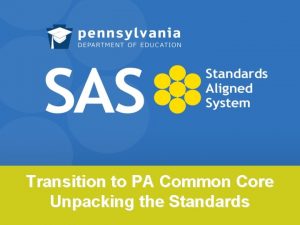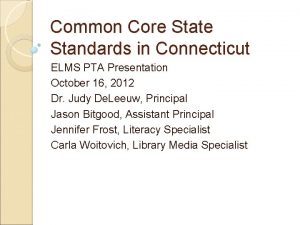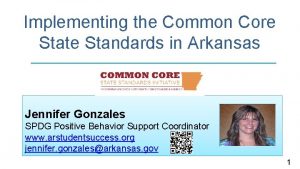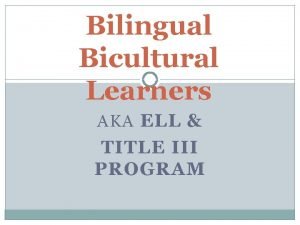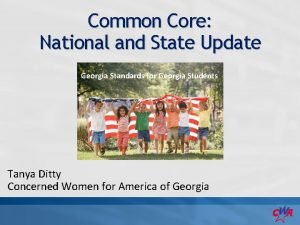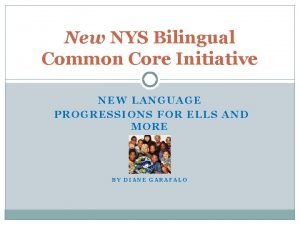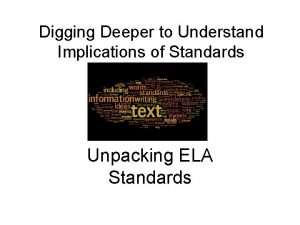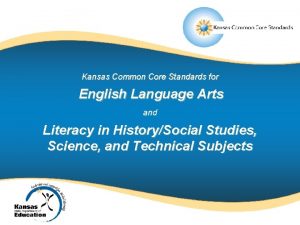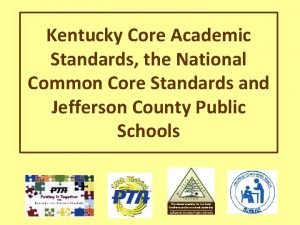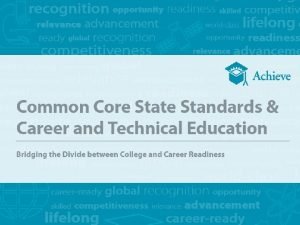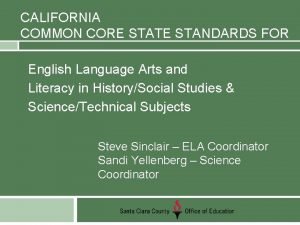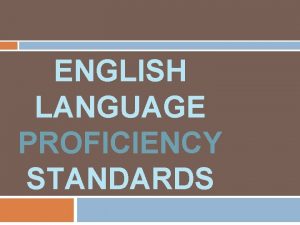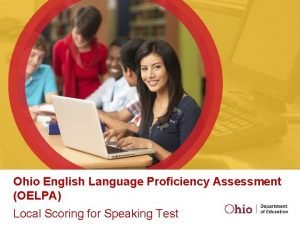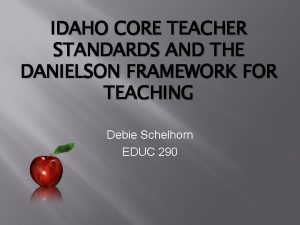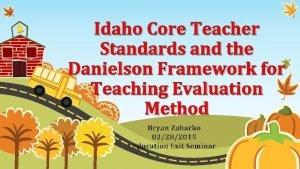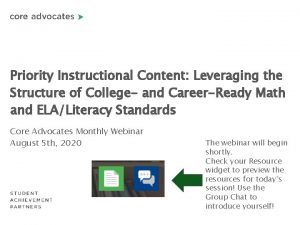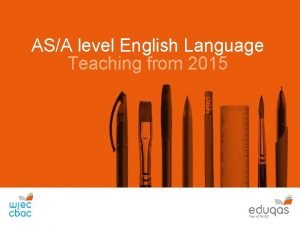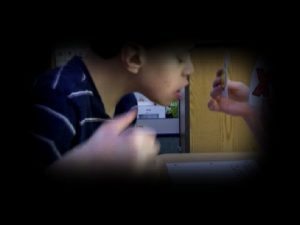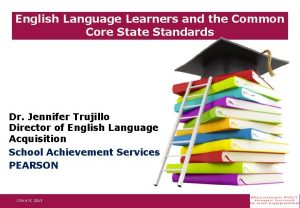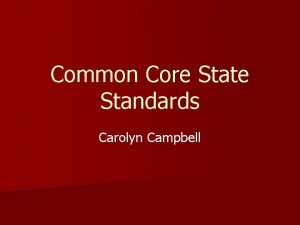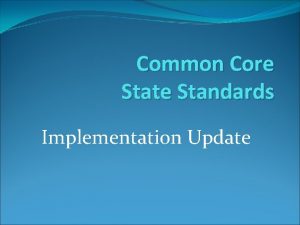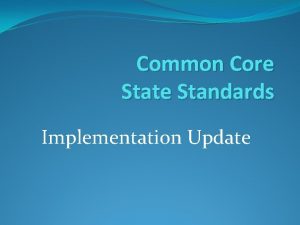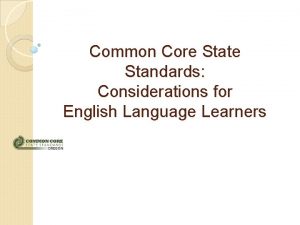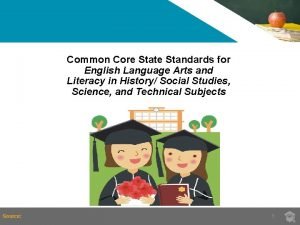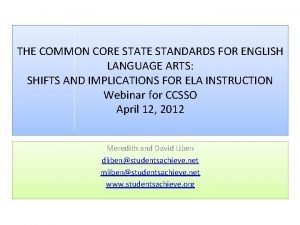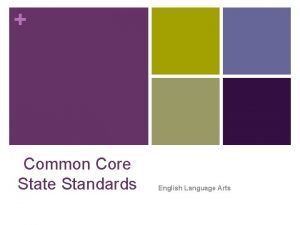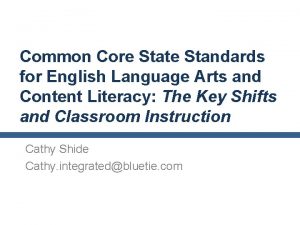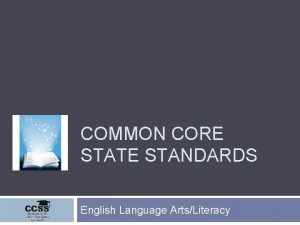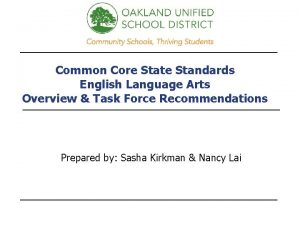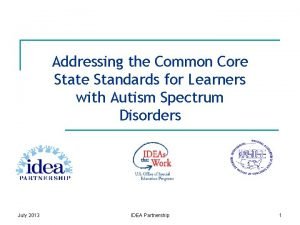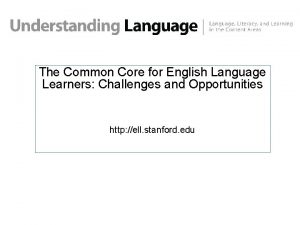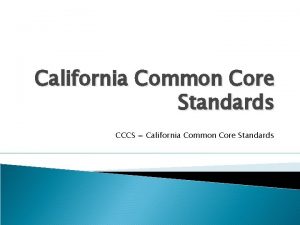Common Core State Standards for English Language Learners






























- Slides: 30

Common Core State Standards for English Language Learners Sarah Porter Coordinator of ESOL and AEL Jefferson City Public Schools

ELL Basics � JUST RELAX! � Language proficiency won’t happen overnight: ◦ BICS (Basic Interpersonal Communicative Skills): 3 -5 years* ◦ CALP (Cognitive Academic Language Proficiency): 47 years* *time estimates vary slightly in research

MAP Concerns � “All English Language Learners (ELLs) must participate in all required Grade-Level Assessments. However, ELLs who have been in the United States 12 cumulative months or fewer at the time of administration of the assessments may be exempted from taking the Communication Arts Assessment…All ELLs must participated in the Mathematics and Science Assessments, regardless of the length of time they have been in the United States. ” –Test Coordinator’s Manual, p 4.

MAP Accommodations � All ELLs, regardless of length of time in the United States, may use approved accommodations. � Handout is from page 43 of Test Examiner’s Manual (2013). � Coordinate with your district ELL staff in advance to determine appropriate accommodations for each student.

MAP Formulas � “Scores for ELL students who have been in the United States three years or less are disaggregated if the district codes a student as LEP/ELL first year monitoring, second year monitoring, receiving services or not receiving services AND identifies the Number of Months in USA as equal to or less than 36 on the MOSIS April Student Core Submission. ” � -DESE, Understanding Your Annual Performance Report (APR), p 4, July 2012.

Components of Academic Language � Bricks: Vocabulary � Mortar: Form/Grammar/Syntax � Foundation: Language Functions

Examples of Language Functions and Forms Language Function Examples of Language Forms Expressing needs and likes Indirect/direct object, subject/verb agreement, pronouns Describing people, places, and things Nouns, pronouns, adjectives Describing spatial and temporal relations Prepositional phrases Describing actions Present progressive tense, adverbs Retelling/relating past events Past tense verbs, perfect (present and past) Making predictions Future tense, conditionals Asking informational question Verbs and verb phrases in questions

Language of Math � Prepositions: ◦ Divided by, divided into ◦ 2 multiplied by 6; x exceeds 2 by 7 Comparatives Greater than, less than, fewer than, as much as Reversals The number a is five less than b. If…then

Language of Social Studies � Cause and effect statements common � Wide variety of verb forms: ◦ “I found Rome a city of bricks and left it a city of marble. ” Augustus is supposed to have spoken these words as he lay dying. He was Rome’s first emperor, and started the first of its great building programs. He claimed that he had over 80 temples rebuilt.

Language of Science � Passive voice � Long noun phrases serving as subjects or objects � If…then � Logical connectors: if, because, however, consequently

WIDA MPI � We have curriculum and standards for ELLs, too! � WIDA � Model Performance Indicators (MPIs) � Indicates grade levels, standards/core content, language proficiency level, language function, type of support

Sample MPI Language function Content stem Type of support Grade 6 Standards 4: (the language of) Science Language Proficiency Level: 3 Developing Language Domain: Reading Identify characteristics and conditions related to natural disasters based on text and pictures.

Putting it together CCSS Language MPI Functions Needed K. SL. 4 Describe familiar people, places, things, and events and, with prompting and support, provide additional detail. Describe the members of a family using pictures and a partner. Identify the language Speaking and Listening Adjectives -colors, size, possessive pronouns Nouns and pronouns -family members (parents, siblings, grandparents) Present tense verb “to be”, “have” e. g. My father is tall. e. g. My mother has brown hair. Compound sentences.

MPI Identify the language By English Proficiency Speaking and Listening Level (ELP) Describe the members Adjectives of a family using -colors, size, pictures and a partner. possessive pronouns Nouns and pronouns -family members (parents, siblings, grandparents) Present tense verb “to be”, “have” e. g. My father is tall. e. g. My mother has brown hair. Compound sentences. ELP 5: My brother is short and has brown eyes. ELP 4: My brother is short. He has brown eyes. ELP 3: My brother short, brown eyes. ELP 2: Brother, short, brown eye. ELP 1: brother, short, brown (uses gestures for eye)



Overview of SIOP � Sheltered Instruction Observation Protocol � Does not water down content, but presents in a way comprehensible for ELLs � Focuses on content instruction and academic language instruction at the same time � Designed for ELLs, but beneficial for all students � Has 8 components and 30 features for lesson design/delivery

#1. Preparation � Content objectives are clearly defined, displayed and reviewed with students � Language objectives are clearly defined, displayed and reviewed with students � Content concepts appropriate for age and educational background level of students

#1. Preparation (con’t) � Supplementary materials used to a high degree to add clarity and meaning (e. g. technology, graphs, models, visuals) � Adaptation of content (e. g. text, assignment) to all levels of proficiency � Meaningful activities that integrate lesson concepts with language practice opportunities for reading, writing, listening, and speaking

#2. Building Background � Concepts explicitly linked to prior knowledge � Links explicitly made between past learning and new concepts � Key vocabulary emphasized

#3. Comprehensible Input � Speech appropriate for students’ proficiency level � Clear explanation of academic tasks � Variety of techniques to make content concepts clear

#4. Strategies � Apple opportunities for students to use learning strategies � Scaffolding techniques consistently used � Variety of questions that promote higherorder thinking skills

� Hierarchy of Questions (keep in mind students’ English proficiency levels!) ◦ Point to �Yes/No �Either/or �Question words (who, what, when, where, why, how) �Open-ended

#5. Interaction � Frequent opportunities for interaction and discussion between teacher/student and among students which encourage elaborated responses � Grouping configurations support content and language objectives � Sufficient wait time � Ample opportunities for students to clarify key concepts in L 1 (first language) as needed with aide, peer, technology, or L 1 text

#6. Practice/Application � Hands-on materials or manipulatives provided for students to practice new content knowledge � Activities provided for students to apply content and language knowledge in the classroom � Activities integrate all language skills (reading, writing, listening, speaking)

#7. Lesson Delivery � Content objectives supported by lesson delivery � Language objectives supported by lesson delivery � Students engaged � Pacing of lesson appropriate to students’ ability levels

#8. Review and Assessment � Comprehensive review of key vocabulary � Comprehensive review of key content concepts � Regular feedback � Assessment of student comprehension and learning (formal and informal) throughout the lesson

Video

Resources � www. wida. us � http: //dese. mo. gov/qs/me/ � http: //ell. stanford. edu/ � www. ccssell. weebly. com

Thank you! � Sarah Porter � sarah. porter@jcschools. us � (573) 659 -3142
 Common core state standards pa
Common core state standards pa Common core state standards ct
Common core state standards ct Common core state standards missouri
Common core state standards missouri Common core standards arkansas
Common core standards arkansas Language tools
Language tools English language learners
English language learners Reading strategies for english language learners
Reading strategies for english language learners Cr part 154
Cr part 154 Georgia common core standards
Georgia common core standards Nlap standards
Nlap standards Unpacking common core standards template
Unpacking common core standards template Ela standards kansas
Ela standards kansas Common core standards ky
Common core standards ky Common career technical core
Common career technical core Teaching young learners english
Teaching young learners english California state standards english
California state standards english English language proficiency (elp) standards scavenger hunt
English language proficiency (elp) standards scavenger hunt Elps standards texas
Elps standards texas Oelpa practice test
Oelpa practice test Inner core and outer core
Inner core and outer core Compare and contrast the crust mantle and core
Compare and contrast the crust mantle and core Crust outer core inner core mantle
Crust outer core inner core mantle Core rigidity
Core rigidity 6 key priorities in health south africa
6 key priorities in health south africa Idaho core teacher standards
Idaho core teacher standards Bryan zaharko
Bryan zaharko Achieve the core priority standards
Achieve the core priority standards Utah core math standards
Utah core math standards Factors determining service standards
Factors determining service standards Levels of language knowledge
Levels of language knowledge Essential elements of state
Essential elements of state
